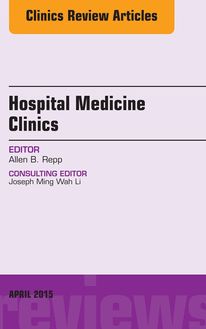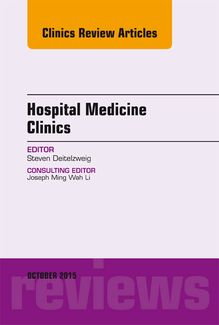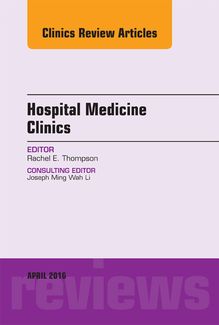Volume 5, Issue 2, An Issue of Hospital Medicine Clinics, E-Book , livre ebook
81
pages
English
Ebooks
2016
Vous pourrez modifier la taille du texte de cet ouvrage
Obtenez un accès à la bibliothèque pour le consulter en ligne En savoir plus
Découvre YouScribe en t'inscrivant gratuitement
Découvre YouScribe en t'inscrivant gratuitement
81
pages
English
Ebooks
2016
Vous pourrez modifier la taille du texte de cet ouvrage
Obtenez un accès à la bibliothèque pour le consulter en ligne En savoir plus
Publié par
Date de parution
20 avril 2016
Nombre de lectures
2
EAN13
9780323417587
Langue
English
Poids de l'ouvrage
1 Mo
This issue of Hospital Medicine Clinics, edited by Dr. Rachel Thompson, covers a broad spectrum of topics including: Cardiovascular Risk Assessment and Modification; Pulmonary Risk Assessment and Optimization, Diabetes and Hyperglycemia in the Surgical Setting; Management of Anticoagulants and VTE Prevention; Planning for Perioperative Pain Management; Medication Management for Patients on Chronic Steroids or Rheumatalogics; Anesthesia Considerations for the Hospitalist; Perioperative Assessment Of and Care for the Elderly and Frail; Quality and Value in Perioperative Medicine; Risk Assessment and Perioperative Care for Patients with Renal or Liver Disease; and Surgical Site Infections!
Publié par
Date de parution
20 avril 2016
Nombre de lectures
2
EAN13
9780323417587
Langue
English
Poids de l'ouvrage
1 Mo
Volume 5, Issue 2
Hospital Medicine Clinics
Editor
Rachel E. Thompson, MD, MPH, SFHM
General Internal Medicine, Section of Hospital Medicine, Clinical care Transitions, University of Nebraska Medical Centre, Omaha, NE, USA
Consulting Editors
Joseph Ming Wah Li
Clinics Review Articles
April 2016
Table of Contents
Cover image
Title page
Contributors
Consulting Editor
Editor
Authors
Forthcoming Issues
Forthcoming Issues
Recent Issues
Preface. High-Value, High-Quality Perioperative Care-A Collaborative Opportunity for Hospitalists
Value in the Perioperative Period
Key points
Value in the policy context
Preoperative period
Postoperative care
References
Perioperative Cardiac Risk Assessment and Management for Noncardiac Surgery
Introduction
Clinical guidelines
Surgical risk and timing
A stepwise approach should be applied
Performance improvement
References
Pulmonary Risk Assessment and Optimization
Epidemiology
Patient evaluation and diagnosis
Patient management
Summary
References
Diabetes and Hyperglycemia in the Surgical Setting
Introduction
Preoperative evaluation
Intraoperative
Postoperative
References
Risk Assessment and Perioperative Care for Patients with Renal or Liver Disease
Perioperative care for patients with renal disease
Perioperative care for patients with liver disease
References
Perioperative Assessment of and Care for the Elderly and Frail
Background and significance
The role of medical perioperative clinics, and geriatric and medical comanagement programs
Summary and future directions
Acknowledgments
References
Venous Thromboembolism Prevention and Perioperative Management of Anticoagulants
Definitions
Risk assessment
Pharmacologic options for venous thromboembolism prophylaxis and treatment
Nonpharmacologic options for venous thromboembolism prophylaxis
Venous thromboembolism prophylaxis in surgical patients
Timing of cessation of anticoagulation, resumption, and duration of treatment
Interruptions in venous thromboembolism treatment and bridging strategies
Reversal
References
Medication Management for Patients on Rheumatologic Agents or Chronic Steroids
Perioperative management of rheumatologic agents
Perioperative management of corticosteroids
Patient selection to receive perioperative stress-dose steroids
Weighing the risks and benefits
References
Anesthesia Considerations for the Hospitalist
Anesthesia primer
Acute sequelae of anesthesia
The hospitalist and quality improvement
References
Planning for Perioperative Pain Management
Preoperative considerations
Opioids
Nonopioid systemic pain medications
Regional pain control
Special populations
Process improvements
Guidelines
References
Surgical Site Infections
Definitions
Background/epidemiology
Pathogenesis
Prevention
Diagnosis and management
Process improvement
References
Contributors
Consulting Editor
JOSEPH MING WAH LI, MD, SFHM, FACP , Chief, Section of Hospital Medicine, Division of General Medicine and Primary Care, Beth Israel Deaconess Medical Center; Associate Professor of Medicine, Harvard Medical School, Boston, Massachusetts
Editor
RACHEL E. THOMPSON, MD, MPH, SFHM , Chief, Section of Hospital Medicine; Medical Director; Associate Professor, Division of General Internal Medicine, Nebraska Medical Center, Omaha, Nebraska
Authors
TREFAN ARCHIBALD, MD , Clinical Instructor of Medicine, University of Washington, Seattle, Washington
JOSHUA H. ATKINS, MD, PhD , Assistant Professor of Anesthesiology and Critical Care and Otorhinolaryngology Head and Neck Surgery, Perelman School of Medicine, University of Pennsylvania, Philadelphia, Pennsylvania
JANE BALLANTYNE, MD, FRCA , Professor, Department of Anesthesiology and Pain Medicine, University of Washington, Seattle, Washington
TIFFANY CHEN, MD , Clinical Instructor, Department of Internal Medicine, University of Washington, Seattle, Washington
STEVEN L. COHN, MD, FACP, SFHM , Director, Medical Consultation Services; Medical Director, UHealth Preoperative Assessment Center, Jackson Memorial Hospital, University of Miami Hospital, Professor of Clinical Medicine, University of Miami Miller School of Medicine, Miami, Florida
REBECCA DALE, DO , Acting Assistant Professor, Department of Anesthesiology and Pain Medicine, University of Washington, Seattle, Washington
NATE DEFELICE, MD , Clinical Instructor, Department of Medicine, University of Washington, Seattle, Washington
ANTHONY DELA-CRUZ, MD , Assistant Professor of Anesthesiology, Rush University, Chicago, Illinois
E. PATCHEN DELLINGER, MD , Professor, Division of General Surgery, Department of Surgery, University of Washington Medical Center, Seattle, Washington
SUPARNA DUTTA, MD, MPH , Assistant Professor of Medicine, Division of Hospital Medicine, Rush University Medical College, Chicago, Illinois
LEE A. FLEISHER, MD , Robert D Dripps Professor and Chair of Anesthesiology and Critical Care; Professor of Medicine, Perelman School of Medicine, University of Pennsylvania, Philadelphia, Pennsylvania
GERMAN E. GIESE, MD , Attending, Division of Hospital Medicine, Assistant Professor of Medicine, University of Miami Miller School of Medicine, Miami, Florida
DIVYA GOLLAPUDI, MD , Clinical Instructor, Division of General Internal Medicine, Harborview Medical Center, University of Washington, Seattle, Washington
PAUL J. GRANT, MD, FACP , Assistant Professor of Medicine; Director, Division of General Medicine, Department of Internal Medicine, University of Michigan Health System, Ann Arbor, Michigan
AMIR K. JAFFER, MD, MBA , Professor of Medicine; Division Chief, Division of Hospital Medicine, Rush University Medical College, Chicago, Illinois
JENNIFER R. LYDEN, MD , Hospital Medicine Program, Clinical Instructor, Department of General Internal Medicine, Harborview Medical Center, Seattle, Washington
ROSELYN MATEO, MD, MS , Assistant Professor of Medicine, Division of Hospital Medicine, Rush University Medical College, Chicago, Illinois
KARA J. MITCHELL, MD , Clinical Assistant Professor, Department of Medicine, University of Washington, Seattle, Washington
MAYA NARAYANAN, MD , Acting Instructor, Department of Medicine, University of Washington, Seattle, Washington
KURT J. PFEIFER, MD , Professor, General Internal Medicine, Department of Medicine, Medical College of Wisconsin, Milwaukee, Wisconsin
DAVID M. ROTHENBERG, MD, FCCM , Professor of Anesthesiology, Rush University, Chicago, Illinois
GERALD W. SMETANA, MD , Professor of Medicine, Division of General Medicine and Primary Care, Beth Israel Deaconess Medical Center, Harvard Medical School, Boston, Massachusetts
REBECCA S. STARR, MD , Geriatrician, Division of Geriatrics, Palliative Care and Post-acute Medicine, Department of Medicine, Baystate Medical Center (BMC); Assistant Professor of Medicine, Tufts University School of Medicine, Springfield, Massachusetts
MIHAELA S. STEFAN, MD, PhD, FACP , Director of Perioperative Clinic and Medical Consultation Program; Research Scientist, Center for Quality of Care Research, Baystate Medical Center; Associate Professor of Medicine, Tufts University School of Medicine, Springfield, Massachusetts
RACHEL E. THOMPSON, MD, MPH, SFHM , Chief, Section of Hospital Medicine; Medical Director; Associate Professor, Division of General Internal Medicine, Nebraska Medical Center, Omaha, Nebraska
LISA W. VERCOLLONE, MD, PharmD , Clinical Instructor of Medicine, University of Washington, Seattle, Washington
Forthcoming Issues
Forthcoming Issues
July 2016
Eddy Chen, Editor
October 2016
Ebrahim Barkoudah, Editor
January 2017
Jesse Theisen-Toupal, Editor
Recent Issues
January 2016
Jeff Glasheen and Mary Anderson, Editors
October 2015
Steven Deitelzweig, Editor
July 2015
Mark Thoelke, Editor
Preface
High-Value, High-Quality Perioperative Care-A Collaborative Opportunity for Hospitalists
Rachel E. Thompson, MD, MPH, SFHM
General Internal Medicine, Section of Hospital Medicine, University of Nebraska Medical Center, 986435 Nebraska Medical Center, Omaha, NE 68198-6435, USA, E-mail: rachel.thompson@unmc.edu
Rachel E. Thompson, MD, MPH, SFHM, Editor
With increasing medical complexity of patients undergoing surgery, there is a clear need for Hospital Medicine to establish a core role in developing collaborative perioperative care programs. Nearly one-quarter of hospitalizations occurring in the United States are for a surgical procedure. While less frequent than medical hospitalizations, surgical hospitalizations are associated with greater costs and longer lengths of stay. Hospitalists focus much of their efforts on improving systems that directly affect these outcomes. In addition, for decades, hospitalists have developed a variety of perioperative care programs in the United States, providing preoperative risk evaluations, preoperative optimization of medical conditions, perioperative comanagement and consultation, and postdischarge care of medical comorbidity for surgical patients. While these programs are clearly present in many institutions, they are not ubiquitous and are indeed highly variable.
By virtue of their training and their presence in the hospital, Hospitalists are well poised to lead efforts improving perioperative care in collaboration with surgical and anesthesia colleagues. Hospitalists have deep experience with quality and systems improvement. Hospitalists engage in caring for complicated and frail patients every day. Hospitalists focus on improving experience and outcomes for patients. Hospitalists see first hand the complications following surgical care. Altogether, the experiences and training hospitalists have makes them a clear partner for programmatic development and systems design in perioperative care. With proper engagement, hospitalists can help to reduce avoidable complications and resp




